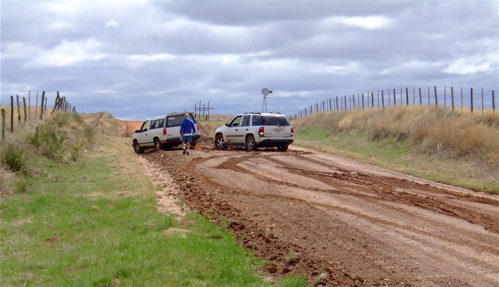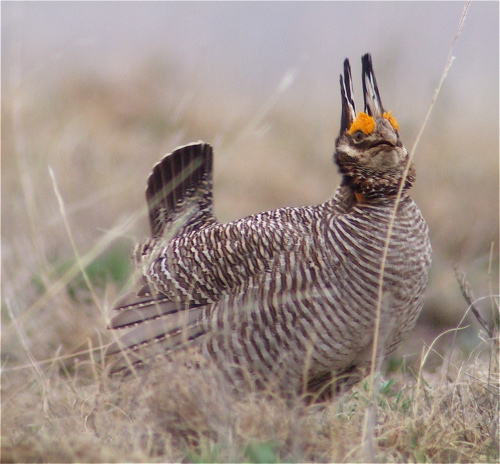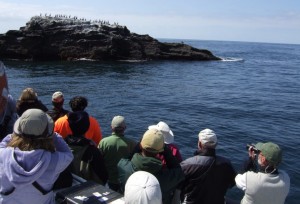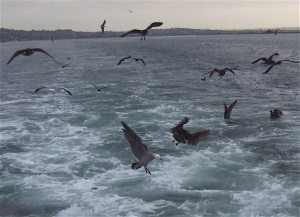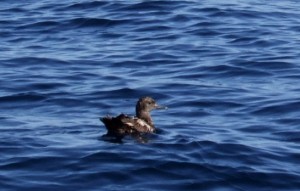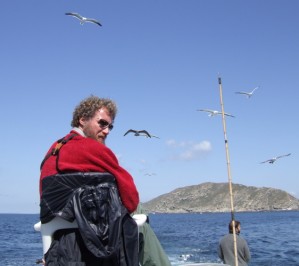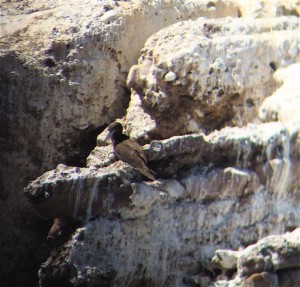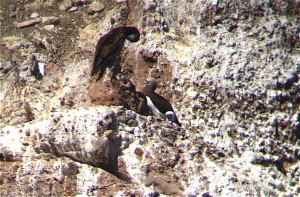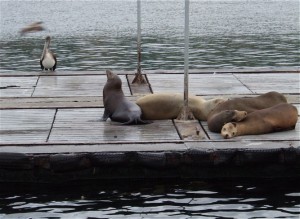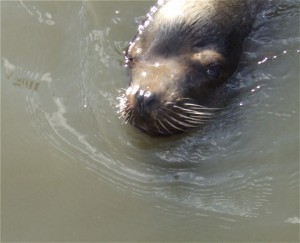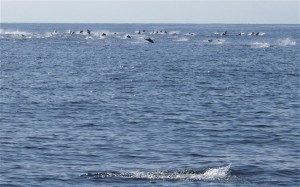NOTE: I just noticed on the Space Coast Birding and Wildlife Festival that they have some items that attendees left behind. If you attended the festival, check it out.
 My final day at the Space Coast Bird Festival in Florida involved a 12 hour pelagic birding trip with the Explorer Fishing Charters. Above is a photo of our boat heading out to sea with a large flock of gulls following us (because we were chumming the water). Pelagic bird trips involve taking a boat out into the ocean to try and see birds that only come to land for breeding. You watch for birds with crazy names like petrels, jaegers, fulmars. Pelagic birding isn't for everyone--and yet for many people, it' the only way to get certain birds on your list. Even if you're not prone to seasickness, watching birds through your binoculars on a bobbing boat can make you barf. It's also a challenge for me because I can't really digiscope from the boat and we have to rely on what ever my little point and shoot can do all on its own.
My final day at the Space Coast Bird Festival in Florida involved a 12 hour pelagic birding trip with the Explorer Fishing Charters. Above is a photo of our boat heading out to sea with a large flock of gulls following us (because we were chumming the water). Pelagic bird trips involve taking a boat out into the ocean to try and see birds that only come to land for breeding. You watch for birds with crazy names like petrels, jaegers, fulmars. Pelagic birding isn't for everyone--and yet for many people, it' the only way to get certain birds on your list. Even if you're not prone to seasickness, watching birds through your binoculars on a bobbing boat can make you barf. It's also a challenge for me because I can't really digiscope from the boat and we have to rely on what ever my little point and shoot can do all on its own.
 The other challenge to pelagic is that there is a lot of gross stuff around. You need to attract birds to the boat and a great way to do that is to dribble some fish oil behind the boat. If you do feel yourself getting sick on a pelagic trip, it's best to go to the back of the boat and blow chow there. If you do it in front or from the side, people behind you could get some residual spray. But it you go in back, you barf can contribute to the chum, but if you're back there with the oil and the fish, it might make you vomit some more.
The other challenge to pelagic is that there is a lot of gross stuff around. You need to attract birds to the boat and a great way to do that is to dribble some fish oil behind the boat. If you do feel yourself getting sick on a pelagic trip, it's best to go to the back of the boat and blow chow there. If you do it in front or from the side, people behind you could get some residual spray. But it you go in back, you barf can contribute to the chum, but if you're back there with the oil and the fish, it might make you vomit some more.
 Also, along with the fish oil, the crew chops up chunks of fish to toss out. Once you get a large flock of common gulls following you, it attracts the attention of other birds. There are several thing you can do to ward off from seasickness. One, the day before don't go out drinking lot alcohol. Have a good dinner--you may think having an empty stomach will make so you have nothing to hurl, but you need a good dinner so you body can function at it' best. The night before take a Dramamine or Bonine. About an hour before you're on the boat, take another Dramamine or Bonine--you need it in your system before you're on the boat for the med to work. If you take it on the boat, chances are good you could just barf it back up. There are also patches, ginger chews, ginger ales that you can use too.
Also, along with the fish oil, the crew chops up chunks of fish to toss out. Once you get a large flock of common gulls following you, it attracts the attention of other birds. There are several thing you can do to ward off from seasickness. One, the day before don't go out drinking lot alcohol. Have a good dinner--you may think having an empty stomach will make so you have nothing to hurl, but you need a good dinner so you body can function at it' best. The night before take a Dramamine or Bonine. About an hour before you're on the boat, take another Dramamine or Bonine--you need it in your system before you're on the boat for the med to work. If you take it on the boat, chances are good you could just barf it back up. There are also patches, ginger chews, ginger ales that you can use too.
 I myself like to tempt fate on a pelagic. I was going to get a shot of me holding one of the frozen fish, when one of the crew put one in his mouth and dared me to do the same. He said not to swallow any ice on the fish and I would be fine--so I went for it. I actually take Bonine, it makes me less drowsy. I do have some motion sickness issues - I can't read in a car or I get nauseous. But I'm fortunate in that the few times I found myself getting woozy on a pelagic, I notice that if I focus on the horizon for a minute, it goes away.
I myself like to tempt fate on a pelagic. I was going to get a shot of me holding one of the frozen fish, when one of the crew put one in his mouth and dared me to do the same. He said not to swallow any ice on the fish and I would be fine--so I went for it. I actually take Bonine, it makes me less drowsy. I do have some motion sickness issues - I can't read in a car or I get nauseous. But I'm fortunate in that the few times I found myself getting woozy on a pelagic, I notice that if I focus on the horizon for a minute, it goes away.
 We got some fun birds mixed in with the gulls. Above is a young northern gannet. I love these guys, especially when they dive for food. I have a dream of someday visiting their nesting colony in Newfoundland. I tried to find video of them diving (there's great footage on the Life of Birds). But I found one homemade video here (you may need to hit mute if you're at work, there's a fun little song along with it) and there here is a video of a crew watching sardines. About a minute and twenty-five seconds into it, you see the gannets from underwater--I didn't realize how much they swim once they dive in!
We got some fun birds mixed in with the gulls. Above is a young northern gannet. I love these guys, especially when they dive for food. I have a dream of someday visiting their nesting colony in Newfoundland. I tried to find video of them diving (there's great footage on the Life of Birds). But I found one homemade video here (you may need to hit mute if you're at work, there's a fun little song along with it) and there here is a video of a crew watching sardines. About a minute and twenty-five seconds into it, you see the gannets from underwater--I didn't realize how much they swim once they dive in!
 We also saw sandwich terns - note how this tern has a black bill (with a yellow tip) and not orange like some of the others you may have seen in the blog.
We also saw sandwich terns - note how this tern has a black bill (with a yellow tip) and not orange like some of the others you may have seen in the blog.
 I was hoping for some jaegers and we got them. We saw quite a few pomarine jaegers. These are predatory birds that only come to land to nest up in the Arctic and spend the rest of the time out at see. On their breeding territories, they eat mostly lemmings, but when out to sea they will follow ships for scraps and steal fish from birds like black-legged kittiwakes.
I was hoping for some jaegers and we got them. We saw quite a few pomarine jaegers. These are predatory birds that only come to land to nest up in the Arctic and spend the rest of the time out at see. On their breeding territories, they eat mostly lemmings, but when out to sea they will follow ships for scraps and steal fish from birds like black-legged kittiwakes.
 Part of the fun of a pelagic trip is seeing other species besides birds, like the sea turtle above. We did see one leatherback and some Man O' Wars, so it wasn't all about the birds. Unlike birding in the landfill, it was a little more challenging pointing out critters on the ocean--there weren't too many landmarks. The Man O' Wars look almost like blue plastic bags floating on the surface--"Hey see what looks like a blue plastic bag at about 2 o'clock? That's a jellyfish!"
Part of the fun of a pelagic trip is seeing other species besides birds, like the sea turtle above. We did see one leatherback and some Man O' Wars, so it wasn't all about the birds. Unlike birding in the landfill, it was a little more challenging pointing out critters on the ocean--there weren't too many landmarks. The Man O' Wars look almost like blue plastic bags floating on the surface--"Hey see what looks like a blue plastic bag at about 2 o'clock? That's a jellyfish!"
 We had a big pod of dolphins, both bottle nose and spotted come check out boat out. I'm sure they were interested in the bit of fish trailing out boat. It was fun to watch groups of about seven line up side by side and swim along with out boat.
We had a big pod of dolphins, both bottle nose and spotted come check out boat out. I'm sure they were interested in the bit of fish trailing out boat. It was fun to watch groups of about seven line up side by side and swim along with out boat.
 They came in quite close to the boat, you could almost see them smiling.
They came in quite close to the boat, you could almost see them smiling.
 As we started the day, it was still chilly. As the boat got closer and closer to the Gulf Stream to look for birds, it got a bit warmer and some of us shed our layers. Most people kept them on. The front of the boat was very crowded and being short I headed towards the upper deck to get a view of the birds. We were lucky in that the seas were quiet and we didn't have too much rocking, blowing, or waves crashing.
As we started the day, it was still chilly. As the boat got closer and closer to the Gulf Stream to look for birds, it got a bit warmer and some of us shed our layers. Most people kept them on. The front of the boat was very crowded and being short I headed towards the upper deck to get a view of the birds. We were lucky in that the seas were quiet and we didn't have too much rocking, blowing, or waves crashing.
 But periodically, waves would splash up--especially if the captain was turning to get a the group a better look at a bird. Notice how wet Leica Rep Jeff Bouton got. He loved it, it's a chance to demonstrate how Leica bins can take a water beating and appeals to his adventurous spirit. Jeff also brought his young son, Austin along for the ride. Austin was my savior at a couple of points when he would head down inside to get me coffee. I paid him in donuts. It was and awesome partnership. If you read WildBird Magazine, Jeff has a column about his birding adventures with young Austin.
But periodically, waves would splash up--especially if the captain was turning to get a the group a better look at a bird. Notice how wet Leica Rep Jeff Bouton got. He loved it, it's a chance to demonstrate how Leica bins can take a water beating and appeals to his adventurous spirit. Jeff also brought his young son, Austin along for the ride. Austin was my savior at a couple of points when he would head down inside to get me coffee. I paid him in donuts. It was and awesome partnership. If you read WildBird Magazine, Jeff has a column about his birding adventures with young Austin.
As it got warmer, I too shed some layers, one being my earmuffs, which were more for keeping my hat on. Now that I have short hair, I don't have the long ponytail to help hold the hat in place. Two minutes later, the wind blew my hat and gave it to the ocean.
 I was a tad bummed, it was a hat from the Rio Grande Valley bird fest--black with an embroidered green jay. I have twenty other hats, so it wasn't that big of a loss, but I felt terrible about accidentally littering the ocean. Before I knew what was going on, the boat turned around...the captain was going back for my hat!
I was a tad bummed, it was a hat from the Rio Grande Valley bird fest--black with an embroidered green jay. I have twenty other hats, so it wasn't that big of a loss, but I felt terrible about accidentally littering the ocean. Before I knew what was going on, the boat turned around...the captain was going back for my hat!
 We went around, both Bouton from Leica and a shipmate tried to fish it out with long hooks. They missed, the captain circled again for the hat. I was shocked at the effort that was being put forth for my hat. I didn't ask for them to go back, they just did.
We went around, both Bouton from Leica and a shipmate tried to fish it out with long hooks. They missed, the captain circled again for the hat. I was shocked at the effort that was being put forth for my hat. I didn't ask for them to go back, they just did.
 On the second turn, the got my hat! I was stunned. I think I now have an official lucky hat. It was dripping wet when they handed it to me...
On the second turn, the got my hat! I was stunned. I think I now have an official lucky hat. It was dripping wet when they handed it to me...
 Here's the crewman who fished out my hat. I put it on right way for a photo. I told the captain, "I can't believe you went back for my hat." He said that I looked so sad when it flew off that he had no choice. Bouton told me that he has lost several hats on pelagics and no captain has ever fished one out for him.
Here's the crewman who fished out my hat. I put it on right way for a photo. I told the captain, "I can't believe you went back for my hat." He said that I looked so sad when it flew off that he had no choice. Bouton told me that he has lost several hats on pelagics and no captain has ever fished one out for him.
Pete Dunne asked, "Hey, Sharon, are you going to blog about the carbon footprint left from going back for your hat?"
I asked, "Would you rather that I littered the ocean there, Pete?"
*On a side note, I just noticed that Pete Dunne has an entry on wikipedia--who knew??? Birder making strides in the mainstream.
 After a full day on the ocean of great sea birds and no vomiting, the group headed back with a large parade of laughing gulls following us.
After a full day on the ocean of great sea birds and no vomiting, the group headed back with a large parade of laughing gulls following us.
 The brown pelicans started following us in too. I love this shot, it looks like the pelican is standing right on the water's surface.
The brown pelicans started following us in too. I love this shot, it looks like the pelican is standing right on the water's surface.
 As we got closer, the captain announced that we had to stop chumming the water. We couldn't go into harbor with hundreds of birds following us, no matter how cool those gannets are. They were a great crew and worked really hard to get us better looks at the fast moving birds on the water. We were all exhausted from the adventure at sea, but it was a great time. To me, any day that involves a boat on open water seems like an adventure.
As we got closer, the captain announced that we had to stop chumming the water. We couldn't go into harbor with hundreds of birds following us, no matter how cool those gannets are. They were a great crew and worked really hard to get us better looks at the fast moving birds on the water. We were all exhausted from the adventure at sea, but it was a great time. To me, any day that involves a boat on open water seems like an adventure.


